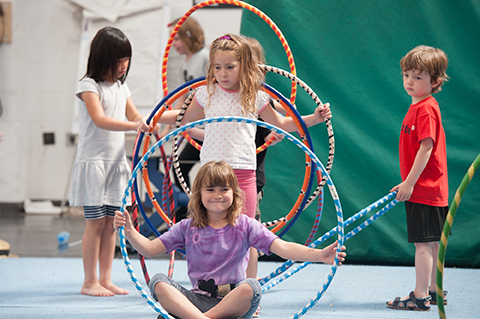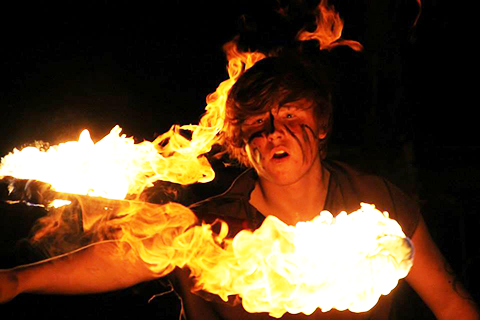As No Fit State celebrates its 30th anniversary, we investigate the lesser-known role of circuses in building healthier futures for the young and disenfranchised
Cardiff-born Chris Moore didn’t plan on the circus when he joined No Fit State for summer school. But forensics, the class for his first-choice, was full. As a child, he suffered with autism, bad health and communication, but a year with the circus saw his life do a 180. Today, the 23-year-old is pursuing circus studies and has become an integral member of the crew – and he’s not alone in his experience. Social circus has helped thousands of disadvantaged people the world over, and continues to do so right at our doorstep.
 Credit: Circus Eruption
Credit: Circus EruptionYouth charity Circus Eruption runs a free, integrated youth circus for children from ages 11 – 19 from all walks of life.
The word ‘circus’ might conjure images of tigers leaping through rings, contortionists, clowns and freakshows, but since its beginning under the big top, the art form has married entertainment with altruism, and its impact is astounding.
Unconventional education
The concept of the ‘social circus’ was born during the circus revival of the 80s, as a medium for the disenfranchised to develop physical literacy, social skills and become part of an inclusive, undiscriminating community.
In the UK, many consider the book Circus in a Suitcase by Reg Bolton as the catalyst for concept of community circus. Bolton, a circus performer himself, claimed it offers six vital experiences otherwise missing from the lives of contemporary Western children: self-design, risk, trust, dream, fun and work.
Today, circus plays an essential role in physical literacy. In 2013, Wales submitted a proposal for physical literacy to be included in the core curriculum of schools, and just last year, the Physical Literacy Programme for Schools was launched with the hope that the framework developed through it will be put into place next year. Given the statistics of childhood obesity in Wales is the highest in the UK, this is an imperative move. Unfortunately, children’s interest in standard PE programmes has been less than enthusiastic, and this is where circus comes in to save the day.
No Fit State’s co-founder Ali Williams has always involved young people and local communities in their art. Frontrunners in Wales’ circus revival of the ’80s, they started their dedicated youth circus in 2004, and currently deliver circus training to PE teachers as part of the Physical Literacy Programme. “If you can learn A-B-C, you learn to read and write, if you learn 1-2-3, you can learn math. Similarly, there are key physical skills you need to learn to develop physically and healthily. Normally, you learn these by being outside – but in today’s generation, our kids miss out,” explains Ali. “If you don’t learn these skills in your developmental years, you’ll be disadvantaged for the rest of your life,” she adds.
 Aside from their youth circus programme, No Fit State also conducts free workshops with refugees and the elderly every week.
Aside from their youth circus programme, No Fit State also conducts free workshops with refugees and the elderly every week.A social lubricant
From No Fit State to Newport Circus, Circus Eruption in Swansea to Organised Kaos in the valleys, Wales has become a hotbed for social circus organisations. Phill Burton, founder of Circus Eruption, Swansea, thinks it has something to do with the fact that circus perfects the balance between sport and art. “It doesn’t include the competitive hot-housing in sport, nor is it as elitist as drama can sometimes be,” says Phill, whose programme also works with hundreds who are homeless, physically or mentally disabled, addicts, refugees or from ethnic minorities. “Circus is inclusive – it doesn’t say ‘you’re not good enough’”, he adds. Neither does it rely on verbal acuity, allowing the disabled to participate in the making of culture.
In 2007, Wales added another social circus to its roster with Organised Kaos opening in the Upper Amman Valley, where teenage anti-social behaviour is high. Like other circus programmes, they teach juggling, aerial, trapeze and a variety of other skills. Within no time, local police began to see a significant decrease of youth-related crime in the area. Today, they engage with over 2,000 people through open-access circuses in parks, football ground and community centres. Thus not only can circus improve obvious areas like concentration, spatial learning, coordination and fitness, but it also helps with self-esteem and social cohesion.
“The idea that participating in circus activities could be good for your health and character development is a very old idea. What social circus does is add a political agenda to that idea, which is that this is very good for people on the margins of society”
 Credit: Organised Kaos
Credit: Organised KaosOrganised Kaos runs by their ‘KAOS Theory’, which instils confidence in individuals, accountability for their actions, and widens their horizons by encouraging positive choices.
Professor Ron Beadle, who started the Circus Research Network last year and comes from a circus family himself, says “The idea that participating in circus activities could be good for your health and character development is a very old idea. What social circus does is add a political agenda to that idea, which is that this is very good for people on the margins of society,” he claims.
“People who have been damaged by power structures can benefit most from it: it’s a discipline, it’s difficult to learn, but there is a real possibility of achievement, and therefore, a quality of liberation to it, useful in helping those who have had a rough deal out of life,” he adds.
Without the competitiveness of sport and the exclusivity of art, circus opens up a space for those left on the sidelines, with benefits running the spectrum from physiological to emotional. The days of parading tigers and dancing midgets may be behind us, but circus has a whole new future ahead of it – one that strives to include us all.
